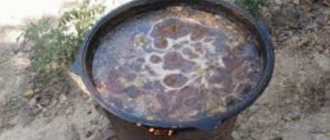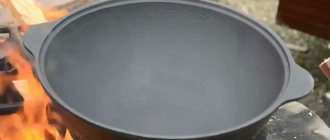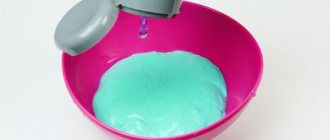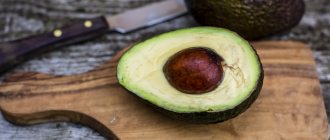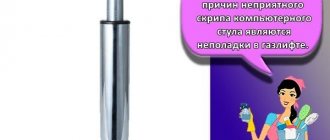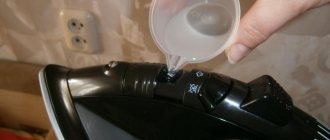A cauldron is a large cast iron pan in which you can cook almost any dish, preserving all its beneficial properties, and which will also come out tasty and aromatic. But, despite its unique qualities, the cauldron is subject to one major drawback - it can rust. To find out how to clean rust from a cauldron, you should read the material presented below.
A cauldron is a large saucepan or kettle, suitable for cooking both on the stove and over an open fire.
Why does a cast iron cauldron become rusty?
There are several reasons why the walls and bottom of a cauldron may corrode, and all of them are associated with improper care of the cookware. When purchasing such outlandish utensils, you need to have a complete understanding of all aspects of care.
If stored improperly and rarely used, kitchen utensils will inevitably rust.
Cast iron becomes rusty due to its porous structure, which allows moisture to accumulate and cause deterioration. Iron is also often added to the alloy during production. Incorrect processing during first use, namely lack of calcination, creates a risk of rust.
A cast iron pot is found in almost every home and is used periodically.
Material matters
The material from which the cauldron is made is of great importance when choosing a cleaning method. The most common option is cast iron. For such a container, the use of household chemicals is strictly contraindicated. The abrasives used in it destroy the protective film of burnt fat, and therefore the coating deteriorates very quickly.
The second most common type is aluminum alloys. They can be washed with mild household chemicals, but abrasives, acids and alkalis cannot be used.
The owner of a copper cauldron is a huge rarity in itself. You can clean it with anything: household chemicals, abrasives, and folk remedies. Anything will do.
Fact!
Recently, cauldrons with non-stick and enameled coatings have appeared on the market. They are not real. Cooking with them over fire is risky. The coating may burst.
How to clean a cast iron cauldron from rust inside
Many owners of cast iron cauldrons are faced with the question of how to remove rust from a cast iron cauldron so that it becomes clean and beautiful again? Many methods have been invented, and they can be divided into two categories: folk remedies, the ingredients for which everyone has in their kitchen drawers, and the use of special chemicals that are sold in hardware stores. Each has both its pros and cons. Only the owner of the dish can decide how to act.
There are many methods on how to clean a cauldron from rust with a minimum of cost.
We use household chemicals
Since the cauldron is not a Teflon frying pan, with a delicate and sensitive coating, it can be cleaned using a variety of methods, including the use of abrasive powders and hard brushes. The procedure is as follows: apply a little powder to a sponge or washcloth, then rub it into places where rust stains accumulate. The cleaned cauldron is thoroughly rinsed and then calcined over a hot fire. This is necessary to prevent new corrosion.
Cauldrons rust if improperly stored and rarely used.
How to clean a cauldron with sandpaper
Sandpaper is quite capable of coping with this kind of problem. It’s better to take two types: large and small. After processing with coarse sandpaper, the rust will turn into dust, which just needs to be washed off with water. For final cleaning, you should rub the walls with fine-grained paper. You need to work carefully so as not to breathe in microparticles; you can even put a gauze mask on your face and comfortable gloves on your hands.
You must follow the instructions to avoid unpleasant consequences.
How to remove with a drill
A rather extravagant way to clean a cast iron cauldron is to cut off the rust with a drill. This method is a bit similar to the previous one because mechanical force will also be used. It is imperative to follow safety precautions. After the procedure, the dishes must be ignited.
Be sure to follow safety precautions when working with a drill.
How to wash with glue and soap
To remove rust this way, you need to prepare. Firstly, you need a large container into which the entire cauldron can fit. If the boiler is larger than ten liters, then most likely it is better to clean it in another way. But a cauldron with a small capacity will do.
Glue and soap help keep the cauldron in good shape.
So, the washed cauldron is placed in a large container filled with water, into which a bar of laundry soap is rubbed and a bottle of silicate glue is poured. The mixture is put on fire and boiled for several hours until a paste forms. After this, the solution is cooled and drained. Once covered with a light film, the cauldron can begin to be cleaned. Soot and rust should come off with it under an ordinary soft sponge. The remains are washed away. The appearance is again pleasing to the eye.
After this treatment, the carbon deposits will come off with regular washing with a soft sponge.
We apply grinding
In order not to have to worry about cleaning at home, you can take the cauldron to the nearest car service center, where they will clean it with a grinding machine (not everyone has such a unit at home). After the procedure, everything necessary is done with the dishes: washed, dried and calcined.
If home cleaning fails, it is recommended to remove the corrosion using a sander.
Cleaning with vinegar
Vinegar is a unique remedy for a wide variety of stains. With its help you can put any thing in order, including a cast iron cauldron.
Pour vinegar, heavily diluted with water, into a large basin. Place the cauldron there for several hours.
There are different combinations of vinegar and other substances that together make cleansing even faster and more effective. The simplest solution is to boil three hundred milliliters of liquid, and the rust will disappear, and the cauldron will again have a glossy shine with black sides.
Afterwards, you can clean the utensils using regular river sand to remove softened carbon deposits.
If you add a spoonful of soda, the process will speed up (everyone knows what reaction is caused by the combination of sodium carbonate and acid).
It is possible to add table salt.
During boiling, you need to move away. If this happens in the kitchen, then you need to open the windows and close the door tightly, because vinegar fumes are harmful to health.
A mixture of soda and salt
These two substances are reliable companions of a good housewife. Despite the abundance of modern detergents, they are widely used in the kitchen because they remove any dirt well, are cheap and harmless.
Afterwards you just need to wash the cauldron and heat it with oil.
To clean, take an equal amount of soda and salt, fill it with water and heat it up. The boiling mixture will remove rust after two to three hours. Depends on the degree of corrosion.
If rust stains have just appeared, they can be removed with a sponge and a very small amount of the mixture.
Simple cleaning methods
Housewives, faced with the problem of a rusty cauldron, do not know what to do. If the rusty coating is not removed in time, the dishes may deteriorate. In order to clean a cast iron cauldron from rust, you can use several methods.
- Household chemicals. In order to wash a rusty cauldron, you can use a special cleaning agent or powder to eliminate rust. After using these substances, it is worth treating the inside of the dishes with a metal sponge and then with sandpaper.
- Surface grinding. This procedure is carried out using a grinding machine.
- Using sandpaper. Initially, a cast iron cauldron should be treated with coarse-grain sandpaper, then with medium-grain sandpaper.
- Using glue and soap. To begin with, the cast iron cauldron is washed well, and the container in which the cauldron will be boiled is filled with water with 100 grams of office glue and a piece of laundry soap. The cauldron needs to be boiled over low heat in the prepared solution. When the cast iron cookware has cooled, it is washed with warm water and the carbon deposits are removed with a washcloth.
- Vinegar . A rusty cauldron must be soaked in a solution that consists of 50% water and 50% vinegar. The dishes must remain in the liquid for at least two hours. Next, you should clean the utensils with a mixture of vegetable oil and coarse salt.
What products should not be used to clean a cauldron?
Although the boiler is quite wear-resistant and insensitive to mechanical stress, there are some prohibited cleaning methods.
It is prohibited to use metal objects to avoid scratching the surface while mixing food.
It is strictly forbidden to scrape the surface with forks, knives or other hard objects that leave scratches. It is not recommended to pour cold water into a hot cauldron, because temperature changes may damage the coating.
It is not recommended to rinse the cauldron immediately after cooking - you need to wait until it cools down.
You should not use hazardous, strong-smelling detergents. They are able to penetrate into the pores of cast iron, from which it is very difficult to wash them out.
What is special about the dishes?
Before cleaning, you need to familiarize yourself with the main distinctive features of such dishes.
What's being cooked
Kazan is considered the national Asian dishware, which is used by housewives in many countries. This is a universal container that is used for preparing most dishes. Thanks to their ideal round shape, cauldrons are used to create the following dishes:
- boiled fish;
- rich soup or borscht;
- pilaf;
- meat dishes;
- sauces.
Sometimes people use cauldrons to create sweet desserts.
Sources of fire
Some people believe that cooking in such dishes can only be done on stoves or gas stoves, but this is not so. Durable cast iron vessels are ideal for long trips and outings. They can be heated on the following fire sources:
- hot coals;
- durable metal grills;
- portable tandoor;
- an iron tripod placed over a fire.
Prevention of corrosion and care of a cast iron cauldron
Any utensils need careful and responsible handling. If, after cooking, the cauldron was not washed well, not wiped dry and put in a cupboard, then it is not surprising that rust will soon appear in it.
Do not store the cauldron in a damp place. After washing, the utensils must be thoroughly dried and only then put away for storage.
To prevent this from happening, you must follow a number of rules:
- Before the very first use, the cauldron is heated. This makes it stronger, food will not stick to the walls, and it will be easier to clean.
- After washing the cauldron, you should dry it well with a soft cotton towel, and leave it in the open air for a while to ventilate and dry better.
- Important: the boiler must be cleaned immediately after cooking. Then you won’t have to deal with dried-on food residues and spoil the surface with harsh shuffles.
- Do not use aggressive agents or steel wool: they destroy the non-stick layer. An ordinary kitchen sponge and odorless liquid soap are sufficient for effective care.
- It is not recommended to pay attention to advertised anti-rust products. All of them contain harmful substances that only worsen the situation. It is much better to use “grandmother’s” remedies.
- Just emerging, barely noticeable rusty spots can be easily removed with the juice of an onion or raw potato.
Causes
Cast iron is a material that rusts, especially when it comes to cookware. Cast iron cauldrons do not rust as quickly as steel ones, as they have a special protective film. This layer is created by regularly wiping the utensils with vegetable oil or during the firing procedure.
The protective film is damaged for the following reasons:
- in the process of scraping the surface of the cauldron using spatulas or skimmers in order to eliminate burnt food;
- when washing cast iron utensils using hard or abrasive brushes and sponges;
- when using chemicals that cannot be used to clean cast iron cookware.
The surface of a cast iron cauldron becomes rusty due to high humidity in the room, as well as if water remains in the utensils after washing.
Utensils for preparing aromatic pilaf and meat can deteriorate when carbon deposits form on it, which appears when the flame is too strong or the dish is not removed from the heat in a timely manner.
How to store a cast iron cauldron so that it does not rust
There are very few rules to follow here.
- After each cooking, the cauldron is washed, dried and placed in a secluded place;
- Ideally, it is best to put the dishes away in a spacious cabinet with doors: it is dry and clean, but dust from the street does not penetrate there;
- The room should also be dry and well ventilated. A basement, garage, shed or some kind of cluttered storage room is definitely not suitable.
- It is recommended to keep the lid separately.
- Do not place other utensils inside: water may leak from them.
Effective methods
If you want to wash rusty deposits from a cast iron cauldron, it is important not to damage the surface of the cookware. Let's look at the most effective methods for getting rid of rust.
- Using acid. In this case, you should use vinegar, soda and salt for the cleaning process. Salt should be poured into the utensils, after which vinegar is poured into it and sent to the fire. After heating the mixture, pour soda into the cauldron, then the composition should boil well. After completing the process, the dishes should be thoroughly washed with water.
- Using baking soda and salt. It is necessary to pour into a cast iron cauldron such an amount of water that would completely cover the rust. Next, pour 0.2 kg of salt and the same amount of soda into the liquid. The cast iron container is placed on the fire and boiled for 120 minutes. After time has passed, the cauldron should be left to cool overnight. You can easily remove carbon deposits from a cooled vessel using dishwashing detergent.
- Sand . To remove rust from dishes, it should be completely covered with sand and then sent to the fire. The cauldron should be heated throughout the night. When morning comes, the sand is poured out of the container, and the cauldron itself is washed with clean water.
- Drill. Using this tool is one of the most effective ways to get rid of rust from a cast iron surface. You need to put a special attachment on the drill and process the surface. The result is similar to the process of using sandpaper. After cleaning is completed, you should wash the dishes.
Preventive actions to prevent corrosion
Corrosion can only be prevented by proper storage and handling. After purchasing, the cauldron must be calcined. There are two main methods - on the stove and in the oven.
Be sure to coat the walls and bottom with oil. And heat until the oil has completely evaporated, after which the cauldron should be allowed to cool. If the kit includes a lid, it also needs to be calcined.
The cauldron must be fired before first use.
The other method is only suitable for the stove. You need to pour 1 kg of salt into the cauldron (or more, depending on the volume). Then keep it on the fire until the salt darkens.
Be sure to cover the pot, as the heated salt may “shoot” during the process.
These tips will help you avoid corrosion over time. Careful handling is also a guarantee that the cauldron will last longer without any signs of rust. It is important to remember that the main cause is moisture - you just need to wipe the dishes dry.
Removing carbon deposits
You can get rid of old traces of food or persistent black stains of soot using methods that can be called radical. To implement the first cleaning method, you need to prepare: a pack of soap, a package of silicate glue, water and a large container. Place all ingredients in hot water and mix them thoroughly. Place the container on the fire and bring the mixture to a boil. Dip the dishes into the container and boil them for an hour. Next, the cauldron is removed and, using a brush, freed from existing contaminants.
The following method will not only clean the cauldron of soot deposits from the outside, but also destroy all bacteria. The inner surface is treated with salt and soda. First, a pack of salt and the same amount of soda are poured into the boiler, after which water is added. After mixing the ingredients, the composition is brought to a boil, after which it is left on the fire for another half an hour. The dirt takes on a different hue, which means it’s time to turn off the heat and allow the metal to cool. Now the treatment should be done using a brush.
You can also clean the cauldron using household chemicals. The optimal ones are those that remove greasy deposits on kitchen hoods or ovens. A unique technique is cleansing using sand. But it’s better to use it not at home, but on a hike, so as not to carry contaminated containers home. To clean the pot, fill it with sand and put it on the fire, where it will remain until the morning. Then the sand is poured out and the cauldron is rinsed.
Storage rules
After each use, aluminum models must be thoroughly washed with a degreaser, rinsed well and wiped dry. Such products should be stored in a dry and well-ventilated area, since the aluminum surface can become a breeding ground for fungus.
Cast iron models should also be thoroughly washed after each use, wiped well and protected from excess moisture.
Instead of fabric, you can use oiled paper - it will also protect the product from moisture and prevent rust.
As you can see, caring for a cauldron at home is not at all difficult. The main thing is to clean it on time and avoid old contamination. And then, sparkling and clean, it will serve its owners for a long time.
For information on how and what to wash a cast iron cauldron, see the following video.
